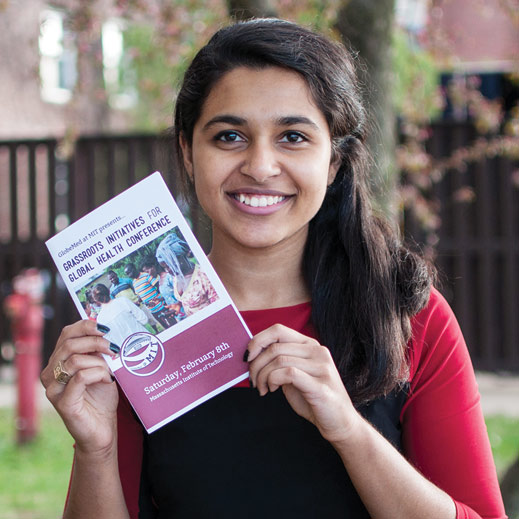What a sight I must have been—a somewhat nicely dressed, slightly disheveled, and clearly sleep-deprived student pushing an unwieldy flatbed cart down the snow- and ice-covered sidewalks of Memorial Drive on a Saturday night in February. Nevertheless, I was on cloud nine.

I was heading back from the Grassroots Initiatives for Global Health conference, the first large-scale event sponsored by the MIT chapter of GlobeMed, a national organization that pairs students with grassroots global health organizations. Since I was one of two conference organizers (my partner in crime was Emma Broderick ’14), the event had monopolized my thoughts for months. Leading up to it, I had been on autopilot: What should I say for the opening? Who is picking up Gini Reticker for the screening of her documentary? Should Mads buy orange or cranberry juice?! More than a few nights were spent dreaming about how the day might unfold. (Sadly, the reindeer that carried me to our Green Building conference room in my dreams did not materialize in reality.)
The conference brought together close to 300 undergraduate and grad students, global health professionals, academics, nurses—you name it. We had expected attendees from Boston but were delighted to welcome folks from as far as Maine and D.C. So why did they all decide to spend their Saturday in an MIT lecture hall?
The conference was meant to provide a forum to exchange ideas for improving global access to health care and let attendees network with others in the field. But our initial expectations were blown away. The audience laughed when a speaker connected global health and chickens but was then hit by the seriousness of his message. He spoke of women in a Liberian village lucky enough to have a clinic who still prefer to face the risks of childbirth at home, because that’s seen as more honorable and thus more deserving of the traditional baby gift, a chicken. His point was that cultural factors can’t be ignored, or the success of global health initiatives will remain just out of reach.
How can we possibly educate ourselves on such seemingly minor but ultimately consequential matters? For starters, it would help for the global health conversation to include the thoughts of those most greatly affected. Our events often highlight powerful CEOs and rich donors, never voicing the thoughts of the community health worker or HIV-positive patient. In fact, our own conference had failed to include anyone who had felt the impact—something we’ve remedied for next year. Nonetheless, our event did inspire people previously uninvolved in global health to join us.
That ability to draw people in from unexpected places is one of the strengths of GlobeMed at MIT. The Institute may not be well known for global health; when I mention my summer at USAID, my fellow bioengineering majors wonder how I could have forgone a summer in the lab. But we capitalize on our members’ technical backgrounds and problem-solving mentalities in a field often lacking such perspective. Through our long-term partnership with Hope through Health, which supports HIV/AIDS clinics for over 1,700 patients in Togo, we’re building the clinics’ technological capacities and fostering a data-driven approach to decision-making. We started with a computer literacy training program we’d designed to help clinic staff transition from paper-based medical records to an electronic system. Initially, some of the clinicians did not even know how to turn on a computer. A year later, laptop use abounds and the training is self-perpetuating. We’ve also trained community health workers to use GIS to map routes when they visit patients. And we’re now implementing mobile health technology to optimize the value of those visits. Our engineering mettle has been put to the test for a truly worthwhile cause.
This is why, as I walked back to my dorm, my ungloved hands freezing to the cart and my stomach protesting the recent lack of food, I was beaming. Pulling off the conference had not been easy, and being involved in global health is challenging. But taking the road less traveled at MIT will, I hope, help me make a difference.
Rafa Rahman ’16, a bioengineering major and public policy minor, is co-president of GlobeMed at MIT (globemed.mit.edu).
Keep Reading
Most Popular
Large language models can do jaw-dropping things. But nobody knows exactly why.
And that's a problem. Figuring it out is one of the biggest scientific puzzles of our time and a crucial step towards controlling more powerful future models.
The problem with plug-in hybrids? Their drivers.
Plug-in hybrids are often sold as a transition to EVs, but new data from Europe shows we’re still underestimating the emissions they produce.
How scientists traced a mysterious covid case back to six toilets
When wastewater surveillance turns into a hunt for a single infected individual, the ethics get tricky.
Google DeepMind’s new generative model makes Super Mario–like games from scratch
Genie learns how to control games by watching hours and hours of video. It could help train next-gen robots too.
Stay connected
Get the latest updates from
MIT Technology Review
Discover special offers, top stories, upcoming events, and more.